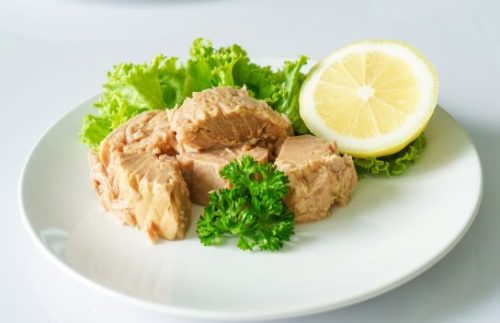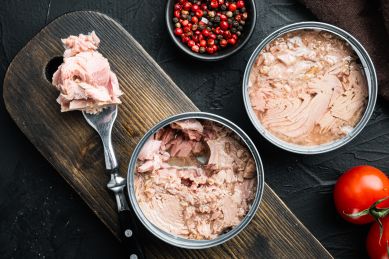Canned tuna is a lunch staple for many people. However, not many know that there are several kinds of tuna, and they are not all created equal. So, how do you choose the best-canned tuna?
Summary Table
| Solid White Tuna | Chunk Light Tuna |
| It contains a large piece of tuna fish. | Contain only pieces or chunks of tuna fish. |
| Made from albacore or escolar. | Made from skipjack tuna. |
| Have a firmer, steak-like texture. | Have a more smooth texture with stronger taste. |
| White or pink color. | Darker white color. |

They are both healthy fish, so you can’t go wrong with either of them. Both of them have their taste, but if you’re looking for a strong taste, solid white tuna would be the best choice. If you’re looking for a mild taste, go for chunk light tuna.
But it’s up to you to decide which one to choose from these two types of tuna!
There are several things to consider when purchasing canned tuna, so you must look at the label carefully. This will give you an idea of what kind of tuna it is.
Some of the more popular types of tuna include solid white tuna and chunk light tuna. Each has its benefits and downfalls.
Solid White Tuna is a light and white tuna, while Chunk Light Tuna contains chunks of tuna. Both are types of tuna but the differences between them can be quite noticeable.
People who eat this type of fish may have different experiences when it comes to how the meat tastes and feels on its tongue.
In this article, we are going to look at the difference between solid white and chunk light tuna. To begin with, let’s understand what tuna is.
Tuna is a type of fish that is primarily caught in the Pacific Ocean. The meat of the tuna has a mild taste, which makes it an ideal fish for cooking. The best way to prepare tuna is to cook it quickly by grilling or frying it so that the meat retains its moisture and flavor.
What Is Solid White Tuna?
Albacore, or long-finned tuna, are members of the tuna family. The albacore species of tuna is found mostly in oceans that are tempered and of high salinity. Also commonly known as canned white tuna, this type of fish is stored in big pieces. They are usually pale pink.
Because of its expensive price, many Japanese restaurants don’t sell albacore to their customers. Instead, they usually give customers escolars and pass them as “white tuna”, rather than serving genuine albacore.
Also called oilfish, butterfish, or waloo, escolars are a very large type in the same family as snake mackerels. It belongs to the “Gempylidae” family and is common in warm waters of the world.
Unlike albacore, escolar has a white and shimmery appearance. Its meat is more firm and oily, as well as has a more prominent odor. Unfortunately, many countries in the world have prohibited this fish to be sold, because of its health factors.

What Is Chunk Light Tuna?
Chunk light tuna is a type of fish that contains chunks of tuna. The flesh of this type of fish can be found in the form of a soft, white, and firm substance.
Chunk light tuna can be sold either as a whole or cut into small pieces. It is often eaten in sushi, sashimi, and poke bowls. The texture and taste can vary depending on how it was caught and processed.
Canned light tuna is high in quality protein, and it is also a good source of vitamin D, B-Complex vitamins, iron, selenium, and phosphorus.
Canned light tuna is often eaten by individuals who are concerned about their health. This type of fish is relatively low in fat and calories, so it is a good alternative to other types of fish that can be found in the market.
Different from solid white tuna, chunk light tuna primarily comes from skipjack tuna. Skipjack tuna is an Atlantic Ocean fish that can grow up to 1.1 meters and weigh up to 34.5 kilograms.
The meat of skipjack tuna contains high amounts of healthy omega-3 fatty acids and vitamin D.
Difference Between Solid White Tuna And Chunk Light Tuna
Solid White Tuna is a type of tuna that has mainly white and pink colors. It contains mainly albacore tuna. Chunk Light Tuna is a type of tuna that has chunks of tuna and contains mostly skipjack tuna.
As we’ve said previously, a solid white tuna is usually made of large, firm pieces of albacore or escalor. If you want to have a tuna steak, this is the one to get. They usually serve it in a can without chopping the meat. It has that chewy steak-like texture that many people enjoy.
Meanwhile, canned chunk light tuna is made from smaller varieties of tuna. The chunky light has a lighter color than white tuna and more moisture.
Since it’s made of small tuna that are caught on fishing nets, the price is more affordable than solid white tuna. However, it has a stronger taste and smoother texture. It’ll make your food taste rich and delicious.
How To Choose Which One Is Right For You?
Solid White Tuna and Chunk Light Tuna are both healthy, but each has its taste. If you prefer solid white tuna, go for it. However, if you prefer the taste of chunk light tuna, it’s the right choice for you.
It also depends on what kind of dish you want to make. If you want a hearty tuna steak, you should go for solid white tuna. However, if you want a piece of tuna that can be used as an appetizer or side dish, go for chunk light tuna.
However, both are perfect choices if you’re looking for healthy meals that would fulfill your protein needs. You can even combine them in your recipes to make your favorite tuna recipes.
Now you know which one is better than the other, so make a choice and enjoy your food!






